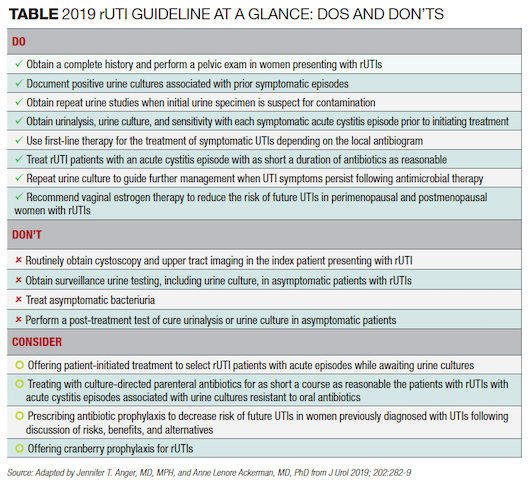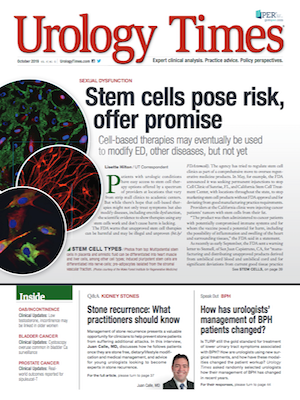Publication
Article
Urology Times Journal
New recurrent UTI guideline: What urologists need to know
The AUA/CUA/SUFU guide focuses on a combination of symptoms and positive cultures.
bongkarn - stock.adobe.com

Uncomplicated urinary tract infection is one of the most common indications for antimicrobial exposure in otherwise healthy women. In the past 20 years, antimicrobial resistance among uropathogens has increased dramatically. Overuse of antibiotics has led to ecological adverse effects known as “collateral damage”-specifically, the selection of drug-resistant organisms and the unwanted development of colonization or infection with multidrug-resistant organisms.
Fluoroquinolones have been linked to infection with methicillin-resistant Staphylococcus aureus and increasing fluoroquinolone resistance in gram-negative bacilli, such as Pseudomonas aeruginosa. Extended-spectrum Ã-lactamase (ESBL)-producing isolates have been described among patients with acute simple cystitis worldwide (Scand J Prim Health Care 2007; 25:49; Br J Gen Pract 2002; 52:729-34). Broad-spectrum cephalosporins have been linked to subsequent infections with vancomycin-resistant enterococci, ESBL–producing Klebsiella pneumoniae, Ã-lactam-resistant Acinetobacter species, and Clostridium difficile.
Also see: Low testosterone, incontinence may be linked in older women
Recurrent urinary tract infections (rUTIs), defined as two culture-proven UTIs in a 6-month period or three culture-proven events in 1 year, make up a large percentage of UTIs seen in urologic practices. Although the American Urological Association has developed a guideline previously, the current climate of antibiotic overuse and resultant “collateral damage,” as well as the development of antibiotic-resistant organisms, has prompted the need for an updated guideline (J Urol 2019; 202:282-9) that is heavily focused on treating not only symptoms, not only cultures, but rather the important combination of symptoms combined with positive cultures.
Prior to developing the guideline, we conducted a systematic review with the methodology team at the Pacific Northwest Evidence-based Practice Center. The final systematic review was conducted in conjunction with input from the Recurrent Urinary Tract Infection expert panel.
The index patient is an otherwise healthy adult female with an uncomplicated, culture-proven recurrent UTI associated with acute-onset symptoms. Central to a diagnosis of UTI is the symptom of dysuria. Dysuria is a highly specific symptom, with more than 90% accuracy for UTI in young women in the absence of concomitant vaginal irritation or increased vaginal discharge.
Next: 16 recommendations16 recommendations
The following 16 recommendations are included in the AUA/CUA/SUFU guideline (table):
Clinicians should obtain a complete patient history and perform a pelvic examination in women presenting with rUTIs. Here it is emphasized that an exam should be performed to identify any treatable contributor to rUTIs, such as vaginal atrophy or cystocele.
To make a diagnosis of rUTI, clinicians must document positive urine cultures associated with prior symptomatic episodes. Since many women have symptoms that may mimic a UTI, such as overactive bladder and interstitial cystitis/bladder pain syndrome, we seek to document all prior episodes with urine cultures before we diagnose a woman as having rUTIs.
Clinicians should obtain repeat urine studies when initial urine specimen is suspect for contamination, with consideration for obtaining a catheterized specimen. Because of the high rate of overtreatment with antimicrobials, a sample with epithelial contamination and/or other factors implicating contamination (such as a culture growing “mixed flora’) warrants obtaining a catheterized sample.

Cystoscopy and upper tract imaging should not be routinely obtained in the index patient presenting with a rUTI. As urologists, we often feel obligated to work up rUTIs, but this is not necessary.
Clinicians should obtain urinalysis, urine culture, and sensitivity with each symptomatic acute cystitis episode prior to initiating treatment in patients with rUTIs. Given what we know about antibiotic resistance, the days of empiric therapy are coming to an end.
Clinicians may offer patient-initiated treatment (self-start treatment) to select rUTI patients with acute episodes while awaiting urine cultures. We no longer advise self-start therapy without cultures. However, in a reliable patient who is committed to checking cultures before starting antibiotics, self-start therapy is still a good option.
Clinicians should omit surveillance urine testing, including urine culture, in asymptomatic patients with rUTIs. If there are no symptoms, we do not want to know what is in the urine!
Clinicians should not treat asymptomatic bacteriuria (ASB). This is very difficult to do, especially when a patient’s primary care provider may wish to treat the patient differently. Often this requires educating the patient’s entire care team.
Clinicians should use first-line therapy (ie, nitrofurantoin, TMP-SMX, fosfomycin) for the treatment of symptomatic UTIs in women depending on the local antibiogram. This information can be obtained from the microbiology lab at the hospital where one practices.
Clinicians should treat rUTI patients with an acute cystitis episode with as short a duration of antibiotics as reasonable, generally no longer than 7 days. Here we are trying to avoid overtreatment of patients with a course of antibiotics that are longer than necessary for acute cystitis.
In patients with rUTIs with acute cystitis episodes associated with urine cultures resistant to oral antibiotics, clinicians may treat with culture-directed parenteral antibiotics for as short a course as reasonable, generally no longer than 7 days. It is reasonable to work with an infectious disease specialist when one’s acute cystitis episode is not treatable with oral agents. Infectious disease specialists often arrange home IV antibiotics.
Read: Positive dipstick does not preclude BTX injections
Following discussion of the risks, benefits, and alternatives, clinicians may prescribe antibiotic prophylaxis to decrease the risk of future UTIs in women of all ages previously diagnosed with UTIs. When carefully selected, appropriate prophylaxis can minimize collateral damage.
Clinicians may offer cranberry prophylaxis for rUTIs. The systematic review identified eight randomized trials including cranberry versus placebo/no cranberry (6 RCTs, one with a lactobacillus arm) and cranberry versus antibiotics (two randomized controlled trials). A number of factors contribute to limitations in use of cranberry consumption in the setting of recurrent UTI outside of a research setting. Juice studies have used a variety of juices and cocktails in varying volumes of daily consumption and have included cranberry of varying concentrations within the overall volume of product ingested. Likewise, cranberry tablets include variability in dosing and are not subject to the same regulatory environment as antimicrobial drugs. Therefore, at this point in time we can recommend cranberry prophylaxis based on its safety profile. However, we need studies that use commercially available products before we can make specific recommendations to patients as to which product is best.
Clinicians should not perform a post-treatment test of cure urinalysis or urine culture in asymptomatic patients. This falls in line with the item above indicating that we should not treat ASB.
Clinicians should repeat urine culture to guide further management when UTI symptoms persist following antimicrobial therapy. This is critical, as patients often present with persistent symptoms despite having a negative culture. By obtaining a culture, we avoid overtreating many of these women.
In perimenopausal and postmenopausal women with rUTIs, clinicians should recommend vaginal estrogen therapy to reduce the risk of future UTIs if there is no contraindication to estrogen therapy. Vaginal estrogen is easy to prescribe for a urologist, as there is no evidence that vaginal dosing contributes to the risk of gynecologic or breast cancers.
More data are needed
One medium risk of bias trial of 140 women with recurrent UTIs who reported <1.5 L/day of fluid intake at baseline (mean age, 36 years) found increased water intake associated with fewer UTI recurrences compared with no additional fluids (mean, 1.7 versus 3.2 UTI episodes over 12 months, p<.001). Increased water intake (three 500-mL bottles of water daily) was also associated with a lower likelihood of having at least three UTI episodes over 12 months (<10% vs. 88%) and greater interval between UTI episodes (143 vs. 84.4 days, p<.001). Further studies are needed to validate this work in women whose water intake is higher at baseline. Vaginal probiotics also hold promise, yet more data are needed before formal recommendations can be made.
Based on the literature to date, however, we believe that the 2019 AUA/CUA/SUFU rUTI guideline is an important step in helping urologists to reduce collateral damage and slow the rate of development of antimicrobial resistance.
Tell us what you think! Email your comments about this article to urology_times@mmhgroup.com.

Jennifer T. Anger, MD, MPH

Anne Lenore Ackerman, MD, PhD
Dr. Anger is associate professor of urology and associate director of urological research, and Dr. Ackerman is assistant professor of urology, Cedars-Sinai Medical Center, Beverly Hills, CA.

Section Editor Christopher M. Gonzalez, MD, MBA, is professor and chair of the department of urology at Loyola University Chicago Stritch School of Medicine, Maywood, IL.






























